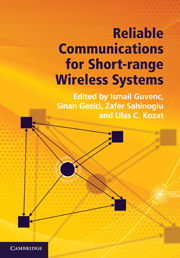Book contents
- Frontmatter
- Contents
- List of contributors
- 1 Short-range wireless communications and reliability
- Part I High-rate systems
- Part II Low-rate systems
- Part II Selected topics for improved reliability
- 11 Cooperative communications for reliability
- 12 Reliability through relay selection in cooperative networks
- 13 Fundamental performance limits in wideband relay architectures
- 14 Reliable MAC layer and packet scheduling
- Index
11 - Cooperative communications for reliability
from Part II - Selected topics for improved reliability
Published online by Cambridge University Press: 01 June 2011
- Frontmatter
- Contents
- List of contributors
- 1 Short-range wireless communications and reliability
- Part I High-rate systems
- Part II Low-rate systems
- Part II Selected topics for improved reliability
- 11 Cooperative communications for reliability
- 12 Reliability through relay selection in cooperative networks
- 13 Fundamental performance limits in wideband relay architectures
- 14 Reliable MAC layer and packet scheduling
- Index
Summary
Chapter 11 describes how teams of wireless nodes can work together to improve the reliability of signaling. Due to the inherent uncertain, time-varying, and shared nature of the wireless environment (reflected in shadowing, small-scale fading, and interference), it is difficult to achieve extremely high reliability over a single wireless link even when advanced signal-processing techniques such as diversity and multiuser detection are employed. However, since wireless transmissions are inherently broadcast – overheard by all nodes within range – a natural approach to reliability is to develop cooperative techniques. Cooperative techniques exploit in parallel many helper nodes, called relays, to increase the diversity of the available wireless links. These techniques can yield large improvements in reliability and throughput as well as large decreases in energy consumption.
The chapter starts with an overview of various cooperative communications methods that can be employed depending on the level of channel state information (CSI) and device synchronization. The chapter then considers two techniques in more detail: relaying using virtual beamforming and rateless codes. In both cases, we start out with an analysis of a “fundamental building block” that consists of one source, a number of parallel relays, and one destination. In the virtual beamforming technique, the relays rebroadcast the source signal that they have decoded. Relays adjust their transmission amplitudes and phases to ensure that their transmissions interfere constructively, maximizing the destination's signal-to-noise ratio (SNR). In the rateless coding approach, the relays individually decode the source message.
- Type
- Chapter
- Information
- Reliable Communications for Short-Range Wireless Systems , pp. 293 - 325Publisher: Cambridge University PressPrint publication year: 2011
- 1
- Cited by



